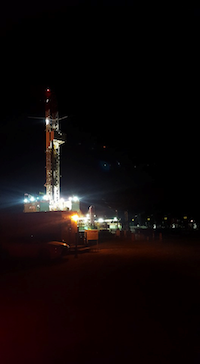
Hydraulic fracturing hasn’t contaminated groundwater in Texas, isn’t an earthquake hazard, and has been a boon for the state’s economy, according to a study released Monday.
The new study’s conclusions on drinking water are in line with multiple other studies of hydraulic fracturing, popularly known as fracking.
Hydraulic fracturing is the process of drilling into rock and injecting a high-pressure mixture of water, sand, and chemicals to obtain shale gas and oil, which is produced from fractured rock. Some environmentalists argue that it can harm water supplies.
The report initiated by the Academy of Medicine, Engineering and Science of Texas, based in Austin, asserted that “direct migration of contaminants from targeted injection zones is highly unlikely to lead to contamination of potential drinking water aquifers.”
To conduct the three-year study, the academy assembled a panel called the Task Force on the Environmental and Community Impact of Shale. The report was written by experts in oil and gas, engineering, transportation, medicine, economics and law, who analyzed existing research rather than conduct new, original research. The task force included oil executives, academics, an oil and gas regulator and a representative from an environmental group.
“In Texas and pretty much everywhere, hydraulic fracturing has not been proven to have an adverse impact on drinking water,” Christine Ehlig-Economides, a professor of petroleum engineering at the University of Houston who is chairwoman of the task force, told The Daily Signal.
The study examined the impact of fracking on drinking water.
“The average annual water use for hydraulic fracturing activities in 2011 and 2012 in Texas was about 20 billion gallons of water,” the report said, citing an Environmental Protection Agency study from last year. “Because this volume represents on 0.2 percent of total water use in the state, and 0.7 percent of total state consumptive use, it might be considered small.”
The study also explored the impact of fracking in five other areas: geology and earthquake activity; land resources; air quality; the economy; and society. It found generally positive results for each.
However, in a sixth category, transportation, the report found that fracking produced a surge of trucks, damaging pavement at an estimated cost to state taxpayers of $1.5 billion to $2 billion per year.
Even so, the study concluded that fracking adds $473 billion to the Texas economy and created 3.8 million jobs.
“Texas has had a long history of oil and gas technology for the world,” Economides said. “Has it had environmental impacts? Yes, it has since it started in the 1850s. But over that time, the industry has learned and corrected those mistakes.”
Last year, the Obama administration’s Environmental Protection Agency completed a five-year study that didn’t find evidence of widespread contamination as a result of fracking. The EPA said fracking can affect drinking water “under some circumstances,” but didn’t cite any confirmed instances and determined there were too many uncertainties about existing data of contamination.
The Texas academy study cited a 2011 Groundwater Protection Council study, which found that 10 of the 211 contamination incidents examined occurred because of drilling and none was related to fracking.
The Texas academy study asserted that direct fracking into rock affecting the state’s drinking water supply “has not been observed in Texas.”
In March, a U.S. Geological Survey of 116 wells across Louisiana, Arkansas, and Texas found fracking was not a major source of chemicals and methane in drinking water wells. It concluded that the detected levels of methane were likely naturally occurring.
A University of Texas study found methane levels from well water in two Texas counties, Parker and Hood, weren’t the result of North Texas’s Barnett Shale, after a sample of 479 wells in those counties.
A Duke University study dated July 2017 noted a “lack of changes in water quality observed in drinking-water wells following the installation of nearby shale-gas wells.”

